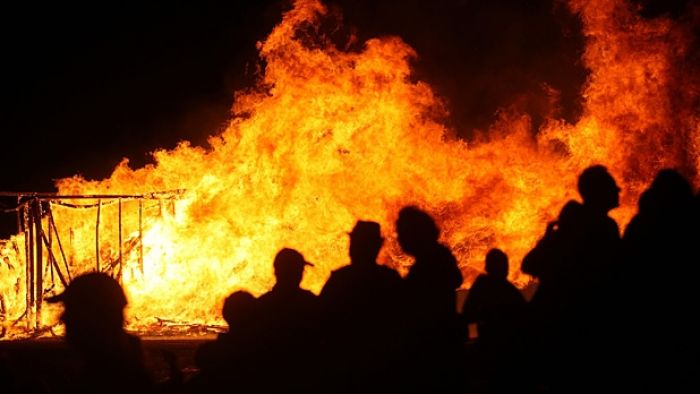The Festival of the Bonfires Lights Up the Levee
Mario Tama / Getty Images
Hindus torch the effigy of a 10-headed bigamist demon. Northern Italians incinerate a straw witch. Scottish rockers fire up a Druid Wickerman. But the citizens of southern Louisiana's St. James Parish outburn them all. Every Christmas Eve, they gather at night on the flat top of a Mississippi River levee and set fire to a six-mile line of massive wooden pyres. As the Festival of the Bonfires rages, they wander down the line sharing drinks and gossip with friends and visitors.
The celebration's historical roots are decidedly unclear. No similar tradition exists in the Acadian communities of the Louisiana bayous so scholars posit that the ritual arrived via subsequent European immigrants in the late 19th century. Some say the fires were first built to light the way for worshippers crossing the river to and from midnight Mass. But over the years, a different explanation has captured young imaginations: The fires are a beacon for Papa Noel (the Cajun Santa) and his eight flying alligators.
Like most rituals, what matters most about the bonfires is not the story of their origin, but the shared experience and thrill of witnessing the massive pyres, the flames visible from miles away. Some 95 percent of the bonfire permits go to the same local families who have celebrated the tradition for generations. Jason Amato, the local fire chief and permit coordinator, built his first bonfire at 5, and 40-odd years later, he and his brothers are teaching their sons and daughters. Building is just as important as burning, he says, a cherished time to be with family, to create something together.
The preferred wood is willow, convenient to harvest from riverbanks and fast to burn. While chainsaws have replaced hatchets, the bonfire structure has remained consistent: a precision-cut four-sided center-pole teepee. Each year, three "non-traditional" pyres are allowed, their designs tend toward the local and iconic. There are shrimp boats, steamboats, models of the state capital, and fleur-de-lis – even a bottle of Jack Daniels.
Among the Amato children, the most coveted task is the lighting. Their elders give them all a chance. While each of the 100-plus fires represents a family, taken together they symbolize a stubbornly thriving community. Rhonda Lee, who spearheads a mid-December pre-bonfire festival, has witnessed the fires for five decades and still tears up when they're lit. She not alone, but men tend to blame it on the smoke.
As much of a tourist draw as the event has become, its spirit is still intimate. Jason relishes seeing the fires through newcomers' eyes and, like many of his neighbors, makes an effort to welcome them. "You talk to the right person," Rhonda says, "you may end up at their house for gumbo."
More information: To see the bonfires, drive 45 minutes upriver from New Orleans to Gramercy, Lutcher, or Paulina, and park in the available lots. Arrive well before 7 pm to see the unburned structures. Drive-by viewing is also possible, but beware of traffic. In 2014, thanks to a new bike path at the levee's base, bikers will be able to pedal the entire six miles of the event. Gray Line also offers several tiers of bonfire bus tours, leaving from New Orleans. For a more distant perspective, American Cruise Lines and the American Queen Steamboat Company both offer weeklong paddlewheel cruises, which include bonfire viewing from the staterooms.
